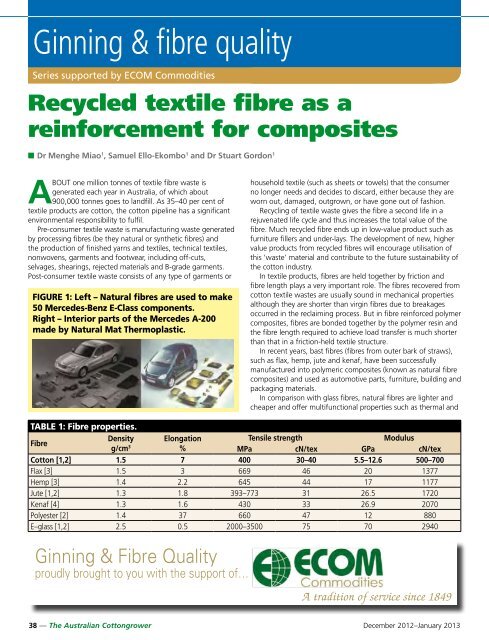cotton - Greenmount Press
cotton - Greenmount Press
cotton - Greenmount Press
Create successful ePaper yourself
Turn your PDF publications into a flip-book with our unique Google optimized e-Paper software.
Ginning & fibre quality<br />
Series supported by ECOM Commodities<br />
Recycled textile fibre as a<br />
reinforcement for composites<br />
■ Dr Menghe Miao 1 , Samuel Ello-Ekombo 1 and Dr Stuart Gordon 1<br />
ABOUT one million tonnes of textile fibre waste is<br />
generated each year in Australia, of which about<br />
900,000 tonnes goes to landfill. As 35–40 per cent of<br />
textile products are <strong>cotton</strong>, the <strong>cotton</strong> pipeline has a significant<br />
environmental responsibility to fulfil.<br />
Pre-consumer textile waste is manufacturing waste generated<br />
by processing fibres (be they natural or synthetic fibres) and<br />
the production of finished yarns and textiles, technical textiles,<br />
nonwovens, garments and footwear, including off-cuts,<br />
selvages, shearings, rejected materials and B-grade garments.<br />
Post-consumer textile waste consists of any type of garments or<br />
FIGuRE 1: Left – Natural fibres are used to make<br />
50 Mercedes-Benz E-Class components.<br />
Right – Interior parts of the Mercedes A-200<br />
made by Natural Mat Thermoplastic.<br />
household textile (such as sheets or towels) that the consumer<br />
no longer needs and decides to discard, either because they are<br />
worn out, damaged, outgrown, or have gone out of fashion.<br />
Recycling of textile waste gives the fibre a second life in a<br />
rejuvenated life cycle and thus increases the total value of the<br />
fibre. Much recycled fibre ends up in low-value product such as<br />
furniture fillers and under-lays. The development of new, higher<br />
value products from recycled fibres will encourage utilisation of<br />
this ‘waste’ material and contribute to the future sustainability of<br />
the <strong>cotton</strong> industry.<br />
In textile products, fibres are held together by friction and<br />
fibre length plays a very important role. The fibres recovered from<br />
<strong>cotton</strong> textile wastes are usually sound in mechanical properties<br />
although they are shorter than virgin fibres due to breakages<br />
occurred in the reclaiming process. But in fibre reinforced polymer<br />
composites, fibres are bonded together by the polymer resin and<br />
the fibre length required to achieve load transfer is much shorter<br />
than that in a friction-held textile structure.<br />
In recent years, bast fibres (fibres from outer bark of straws),<br />
such as flax, hemp, jute and kenaf, have been successfully<br />
manufactured into polymeric composites (known as natural fibre<br />
composites) and used as automotive parts, furniture, building and<br />
packaging materials.<br />
In comparison with glass fibres, natural fibres are lighter and<br />
cheaper and offer multifunctional properties such as thermal and<br />
TABLE 1: Fibre properties.<br />
Fibre<br />
Density Elongation<br />
Tensile strength<br />
Modulus<br />
g/cm 3<br />
%<br />
MPa<br />
cN/tex<br />
GPa<br />
cN/tex<br />
Cotton [1,2] 1.5 7 400 30–40 5.5–12.6 500–700<br />
Flax [3] 1.5 3 669 46 20 1377<br />
Hemp [3] 1.4 2.2 645 44 17 1177<br />
Jute [1,2] 1.3 1.8 393–773 31 26.5 1720<br />
Kenaf [4] 1.3 1.6 430 33 26.9 2070<br />
Polyester [2] 1.4 37 660 47 12 880<br />
E–glass [1,2] 2.5 0.5 2000–3500 75 70 2940<br />
Ginning & Fibre Quality<br />
proudly brought to you with the support of…<br />
A tradition of service since 1849<br />
38 — The Australian Cottongrower December 2012–January 2013

















